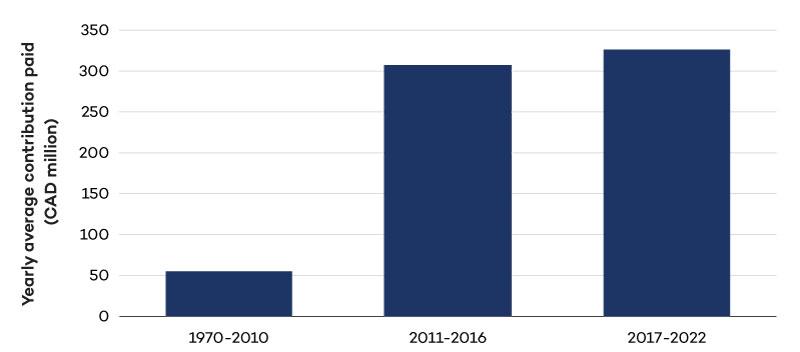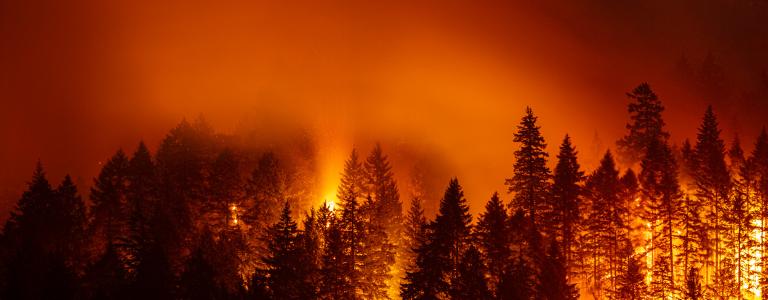Why Canada Needs to Transform Its Approach to Funding for Climate Disaster Recovery
This summer, Canada endured its worst wildfire season on record. The ecological, health, and livelihood losses due to these fires are immense—as will be the costs of rebuilding and recovery. These events come on the heels of Hurricane Fiona and the windstorms in Ontario and Quebec in 2022, which alone caused over CAD 800 million and CAD 1 billion, respectively, in insured damages.
When large-scale disasters such as these occur, provincial and territorial governments can turn to the federal government to help fund a portion of their response and recovery costs through the Disaster Financial Assistance Arrangements (DFAA) program. With the number of climate-related disasters increasing, the federal government is now spending billions of dollars annually through the DFAA program to support post-disaster recovery.
Of the CAD 7.9 billion in assistance paid by Ottawa since the start of the DFAA program, approximately three quarters was distributed in the past 10 years. The 2021 wildfires and flooding in British Columbia alone required CAD 1.5 billion in DFAA payments, and recovery costs for Hurricane Fiona in 2022 may exceed CAD 1 billion. Reflecting these rising costs, the annual budget for DFAA payments jumped from CAD 100 million in 2022/2023 to CAD 1,724.9 million in 2023/2024.

In its 2023 budget, the Government of Canada committed funding for a modernized DFAA program to support the mitigation of disaster risks. As outlined in the November 2022 report of a federally commissioned advisory panel, modernizing the DFAA provides an opportunity to increase the climate resilience of Canadian communities and avoid future costs. By pivoting the program from being solely focused on disaster response and recovery to including disaster prevention and resilience, the DFAA program could become an important tool used to fund adaptation projects across Canada.
What is the DFAA program?
Established in 1970 and administered by Public Safety Canada, the federally funded DFAA program provides financial assistance to the provinces and territories in the event of a large-scale natural disaster. As of January 2023, provincial and territorial governments can request access to these arrangements when their recovery costs exceed CAD 3.61 per capita of their population. As the cost of disasters increases, so too does the share covered by the federal government. The federal government pays an average of 82% of eligible disaster costs: these include emergency shelters, repairs to public infrastructure, and restoration of businesses or homes.
Why does the DFAA program need to be modernized?
For years, the DFAA program has been critiqued for being inefficient and lacking the flexibility to respond to changing circumstances and the unique needs of different communities across the country.
A major criticism of the program, though, is that it is primarily financing disaster response and recovery—as opposed to disaster prevention. Moreover, its requirements make it impossible for provincial and territorial governments to invest in initiatives that build resilience, such as relocating buildings away from high-risk flood zones or requiring homes to be built to better withstand wildfires. This situation is at odds with Canada's current emergency management strategy and commitments under the Sendai Framework for Disaster Risk Reduction, both of which emphasize preventing and reducing the negative impacts of disasters.
This means that, over the past 50 years, nearly CAD 8 billion has been spent reacting to disasters across Canada with limited mechanisms to ensure any of this funding actively prevents these disasters from occurring—even in areas where disasters are preventable and predictable.
How can the DFAA program be improved?
With the cost of disasters increasing every year, in 2022, Public Safety Canada established an expert advisory panel to "review and make recommendations on how to improve the sustainability and long-term viability of the program." In their November 2022 report, Building Forward Together, the panel members called for the DFAA program to play a much larger role in incentivizing disaster risk reduction and building long-term climate resilience. In its 10 recommendations, the panel called for
- establishing an integrated disaster-resilience standard and associated national resilience rating system, which would help Public Safety Canada target funding measures to reduce the impacts of climate-related disasters and support climate change adaptation;
- ensuring that federal finance strategically targets vulnerable populations, as informed by the national resilience rating system;
- improving the coordination and alignment of federal programs for disaster risk reduction and climate change adaptation to ensure measures are implemented meaningfully;
- ensuring stakeholders have access to the information, tools, and capacity they need to be aware of their risk levels and make informed decisions; and
- increasing the program’s efficiency by digitizing and streamlining the application process, providing better access to guidance, and improving responsiveness, as well as making the program more flexible to differing needs between and within regions.
Implementing these recommendations would fundamentally change the focus of the DFAA program from responding to climate-related disasters as they happen to taking steps needed to anticipate, prevent, and reduce these events—consistent with ongoing efforts to adapt to climate change.
How does this relate to Canada’s National Adaptation Strategy?
In June 2023, Canada's first National Adaptation Strategy (NAS) was released. Disaster resilience is one of the five key systems around which the strategy is organized. Consistent with the commitment made in Canada’s 2023 budget, the NAS includes a target of modernizing the DFAA program by 2025 "to incentivize disaster risk reduction and improve recovery outcomes from large-scale disasters." However, meeting the NAS target will require a significant amount of work in a relatively short amount of time; ensuring that these modernization efforts truly allow Canada to better prepare for and recover from climate-related disasters will likely be challenging. The federal government will also need to reach agreements with provincial and territorial governments.
Building resilience to climate change and extreme weather events is not just a Canadian endeavour. Countries throughout the world have struggled to better align and integrate their climate change adaptation and disaster management efforts. In August 2023, the United States Federal Emergency Management Agency announced nearly USD 3 billion in funding for various adaptation projects. This follows an observed trend of greater understanding among national governments of the need for a more integrated approach to climate change adaptation and disaster risk reduction efforts to achieve their sustainable development goals.
What’s next?
The frequency and cost of climate-related disasters are increasing across Canada. Federal financial assistance arrangements must change to meet this growing challenge. They should focus on reducing and preventing the damage caused by floods, fires, and hurricanes rather than simply providing more funding for disaster response and recovery. Federal funding can include provisions that lead provincial and territorial governments to incorporate adaptation measures into pre-disaster planning and post-disaster rebuilding. Crucially, we need meaningful governance systems to integrate climate adaptation and disaster prevention measures across federal departments and between federal and provincial agencies.
Without a greater focus on disaster prevention that accounts for climate change, Canada will only see a rising bill tied to increasingly devastating natural disasters. The DFAA program is a critical tool to help people across the country withstand these events now and into the future, but it is in desperate need of sharpening to support long-term resilience.
You might also be interested in
Why Liquefied Natural Gas Expansion in Canada Is Not Worth the Risk
An analysis of the economic and environmental risks of liquified natural gas expansion in Canada.
New Report Highlights Economic and Environmental Costs of Canada’s LNG Expansion
New report explains how LNG expansion will not only hamper Canada’s progress toward its climate goals but also create challenges for the economy in the long term.
Ottawa supports Big Oil over the climate
One can only imagine the positive buzz these days inside the boardrooms of Canada's oil companies, as they rake in record profits and plan major expansions of their oil production. Amid all the good cheer, one could easily lose sight of the fact that those plans will push the world dangerously closer to the brink of irreversible climate chaos. Even as the world finally signed a commitment at UN climate talks last month to begin transitioning away from fossil fuels, Canada's major oil companies are poised to do exactly the opposite — to greatly expand their fossil fuel production.
Carbon Minefields: Oil and gas exploration surging to pre-Covid levels
Oil and gas exploration is booming despite an agreement at last year’s COP 28 climate summit to transition away from fossil fuels.
